All issues

Volume 1 (1981)
- Issue 1 Pages 1-
Volume 1, Issue 1
Displaying 1-5 of 5 articles from this issue
- |<
- <
- 1
- >
- >|
-
George Mulholland, Takashi Handa, Osami Sugawa, Hirochika Yamamoto1981Volume 1Issue 1 Pages 1-31
Published: 1981
Released on J-STAGE: September 16, 2009
JOURNAL FREE ACCESSThe filling of an enclosure by smoke generated by a diffusion flame was studied by measuring the smoke extinction coeffcient and temperature versus height during the filling process. Semi-quantitative agreement is found between the Bains-Turner theory and experiments with the burner located in the center of the room for heat fluxes over the range 11 to 32 KW. The filling process was found to be about twice as fast when the burner was moved off center. A novel technique for generating a thin smoke layer is described. Approximately 80% of the total heat generated by combustion was lost to the ceiling and walls. It was found that the conservation ratio of fuel to particulate is a non-linear function of fuel flow rate and that the shape of the curve is sigmoidal, which appears to be a common characteristics of sooting system.View full abstractDownload PDF (1973K) -
Tomoyuki Mizuno, Fumitaka Sasagawa, Satoru Horiuchi, Kunio Kawagoe1981Volume 1Issue 1 Pages 33-44
Published: 1981
Released on J-STAGE: September 16, 2009
JOURNAL FREE ACCESSUrethane foam mattresses were burnt in a room and the burning rate of the foam, the horizontal temperature and velocity distribution in the plume, and the descent speed of the smoke layer under the ceiling were measured. Then, the flame spread on the surface of the foam, the flame height, the smoke filling under the ceiling and the characteristics of the plume are discussed. Finally, the dimensionless temperature and the dimensionless velocity are calculated using the experimental data in comparison to Yokoi's results in his methanol experiment.View full abstractDownload PDF (2271K) -
Takashi Handa, Osami Sugawa1981Volume 1Issue 1 Pages 45-69
Published: 1981
Released on J-STAGE: September 16, 2009
JOURNAL FREE ACCESSWith regard to the horizontal motion of hot fire products from a growing fire source in a full scale concrete corridor, velocity and temperature were measured using newly designed smoke-wire systems and an array of thermocouples. Based on the photographic records of vertical profiles of velocity and together with those of temperature, the horizontal motion subject to the turning process can be divided into two regimes: A supercritical region with jump where both the Reynolds number and the ratio of Reynolds number to Richardson number exceeds 3 × 104. Succeeding it is a subcritical region where slight mass extraction occurred through the free interface. It was found that the average velocity increased in proportion to the 1/3 power of the burning rate and was dominated by the magnitude of heat conductivity of the ceiling material. Covering these two regimes, the consistency of the relationship between buoyancy and apparent circulation was confirmed instead of the buoyancy-momentum relationship, except in the earlier stage of combustion.View full abstractDownload PDF (2053K) -
Fumio Hara1981Volume 1Issue 1 Pages 71-90
Published: 1981
Released on J-STAGE: September 16, 2009
JOURNAL FREE ACCESSThis paper presents a mathematical model of the evacuation flow of civilians over a large-scale network consisting of roads, intersections, residential blocks, evacuation goals, and surrounding areas. The model is constructed from two basic laws in evacuation dynamics -- the continuity law of human evacuation and the empirical relation between walking velocity and the concentration of people. The essential part of this model is of determining the evacuation flow direction utilizing a newly-defined psychological potential generated from the human fear of large fires and the concommitant wish to reach an evacuation goal. The computer simulation model was proved to produce a reasonable evacuation process through a good agreement of simulation results with those from the Great Kanto Earthquake disaster which occurred in 1923 in the Tokyo area.View full abstractDownload PDF (1127K) -
Takashi Handa, Masahiro Morita, Kenji Hayashi, Tadahiro Ishii1981Volume 1Issue 1 Pages 91-110
Published: 1981
Released on J-STAGE: September 16, 2009
JOURNAL FREE ACCESSIn order to characterize the motion of the heat flow induced by fire in a real large-scale tunnel as well as the transport of the toxic gases, experimental and theoretical analysis the motion of the heat flow were investigated in a long-scale model tunnel. The computer simulation on the heat flow was conducted by using the Boussinesq approximation and Navier-Stokes' type formula as the viscous heat-conducting incompressible fluid. After recognition of a good correspondence on the heat flow properties between the simulated and experimental results, the computer simulation was scaled up by three times the length of the model tunnel. The life hazard of passengers was also discussed on the basis of the predicted CO gas concentration in the under-layer.View full abstractDownload PDF (1233K)
- |<
- <
- 1
- >
- >|